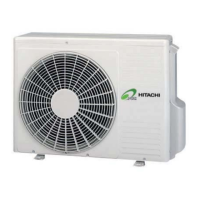27
INSTALLATION AND OPERATION MANUAL
ENGLISH
2. Mount the piping cover in order to avoid water entering into the
unit. Seal the holes where pipes and wires are inserted, by using a
insulation (eld-supplied).
3. If the eld-supplied piping is connected with stop valves directly, it is
recommended use a tube bender.
4. Check to ensure that the stop valves are closed completely before
connecting pipes.
5. Connect the eld supplied refrigerant pipes to the indoor unit and
outdoor unit. Apply the oil thinly at the seat are nut and pipe before
tightening.
The required tightening torque is as follows:
Pipe Size Tightening Torque (Nm)
Ø 6.35 mm 20
Ø 9.53 mm 40
Ø 12.70 mm 60
Ø 15.88 mm 80
6. After connecting the refrigerant piping, seal the open space between
knockout hole and refrigerant pipes by using insulation material.
Unit
Side
Nº Description
Insulation Material
Insulation Material
Field Supplied
Insulation Material
7. Operation of stop valve should be performed according to the gure
below.
Close before shipment
Nº Description Remaks
Cap
Allen wrench Fig.A: Hex 4 mm / Fig.B: Hex. 8 mm
Refrigerant Piping Field Supplied
Flare nut
Refrigerant Pressure To Outdoor Unit
Seat Surface Fully closed position
Check Joint Only the charging those can be connected
Cap
O-Ring Rubber
Spindle valve
Open – Counterclockwise
Close – Clockwise
Tighten torque (N.m)
Valve type Model A B C D
Fig.A
Liquid Valve: 3~6HP (IVX/ES) 7~9 37 60 16
Gas Valve:
3HP (IVX)
4~6HP (ES)
9~11 34~42 68~82 14~18
Fig.B Gas Valve 5~6HP (IVX) 9~11 30 60 9
¡ Outdoor unit stop valve
CAUTION:
At the test run, fully open the spindle.
If not fully opened, the devices will be damaged.
Do not attempt to turn service valve rod beyond its stop.
Do not loosen the stop ring. If the stop ring is loosened, it is
dangerous since the spindle will hop out.
An excess or a shortage of refrigerant is the main cause of
trouble to the units. Charge the correct refrigerant quantity
according to the description of label at the inside of service
cover.
Check for refrigerant leakage in detail. If a large refrigerant
leakage occurs, it will cause difculty with breathing or harmful
gases would occur if a re was being used in the room.
¡ Evacuation and refrigerant charge
− Connect the gauge manifold using charging hoses with a vacuum
pump or a nitrogen cylinder to the check joints of the liquid line and
the gas line stop valve.
− Check for any gas leakage at the are nut connection, by using
nitrogen gas to increase the pressure at 4.15 MPa for outdoor units
inside of the eld-supplied piping.
− Operate the vacuum pump for 1 to 2 hours until the pressure
decreases lower than a pressure of 756 mmHg in vacuum.
− For charging refrigerant, connect the gauge manifold using charging
hoses with a refrigerant charging cylinder to the check joint of the
liquid line stop valve.
− Charge the proper quantity of refrigerant according to the piping
length (Calculate the quantity of the refrigerant charge).
− Fully open the gas line stop valve, and slightly open the liquid line
stop valve.
− Charge refrigerant by opening the gauge manifold valve.
− Charge the required refrigerant within the difference range of ±0.5kg
by operating the system in cooling.
− Fully open the liquid line stop valve after completing refrigerant
charge.
− Continue cooling operation for more than 10 minutes to circulate the
refrigerant.
Thermal insulation
Gas line
Cover the are nut and union
of the piping connection with
thermal insulation
Liquid line
Liquid stop valve
Gas stop valve
Nitrogen tank
(For air Tight test
& Nitrogen blow
during brazing)
Vacuum cylinder
Manifold
gauge
Outdoor unit
Insulate the liquid pipe for
prevention of the capacity
decrease according to the
ambient air conditions and the
dewing on the pipe surface by
the low pressure
Example of Evacuation and Refrigerant Charge.
Do not apply two
spanners at this
position. If applied,
leakage will occur.
Stop valve
Flare nut
PMML0197_r0_04-10.indb 27 08/07/2010 9:20:41

